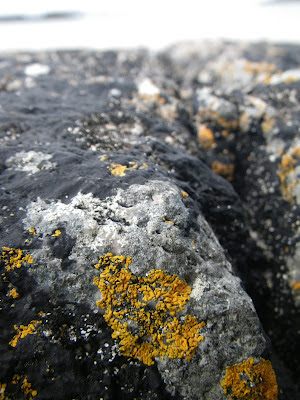Rock pooling destination: Land’s End Peninsula,
England, 2012
The bay
experiences a dynamic regime, alternating between periods of erosion and deposition.
The underlying substrate is boulders, however, variable amounts of sand may be deposited
on top, sourced from the sand bar situated offshore. The communities encountered
reflect the alternation between these regimes.
At the
time of visitation the beach was mainly sand with boulders exposed in the
region of the river and amongst out cropping bedrock in the mid to lower shore.
The highest abundances of organism are encountered on the most persistent substrate, which is the hard substrate that does not experience sand deposition, mainly the steep sloping bedrock that forms the base of the cliff and represents the upper shore. This environment is dominated by barnacles, with limpets, periwinkles, whelks and the coral weed Corallina officnalis all of which are characteristic of a high energy regime environment.
The lower
shore is more characteristic of a moderate energy regime with focuids and the red
seaweed Mastocarpus stellatus
covering boulders and bedrock, additionally Rhodothamniella
floridula is present where sand scours the boulders.
The hard
substrate of the upper shore can broadly be characterised under the habitat
classification: LR.HLR.MusB
(Mussel and/or barnacle communities) and the hard substrate of the mid and
lower shore can be broadly characterised under the habitat classification: LR.MLR.BF
(Barnacles and fucoids on moderately exposed shores); whilst the sand can be
characterised as LS.LSa (Sublittoral sand).
Below are photographs of some of the organisms
encountered
whilst rock pooling in this habitat.
 |
| Fresh water influx to the shore. |
 |
| The sediment type of the beach varies temporally between sand and boulders; the river has washed away the superficial layer of sand to reveal the boulders that occur across the bay beneath the sand. |
 |
| Barnacles and Lipets (Patella vulgata). Habitat classification: LR.HLR.MusB (Mussel and/or barnacle communities) |
 |
| Dog whelk (Nucella lapillus). |
 |
| Mastocarpus stellatus |
 |
| Coralline algae are confined to the crevise where water seeps from a rock pool above. |
 |
| Limpets (Patella vulgata) attach themselves to a boulder that has been covered by sand. |
 |
| Strand line of kelp and Ulva spp. |
 |
| Barnacles and Limpets (Patella vulgata). |
 |
| Serrated wrack (Fucus serratus). Habitat classification: LR.MLR.BF
(Barnacles and fucoids on moderately exposed shores). |
 |
| Serrated wrack (Fucus serratus). |
 |
| Mastrocarpus stellatus and sand binder (Rhodothamniella floridula). Biotope classification: LR.MLR.BF.Rho (Rhodothamniella floridula on sand scoured lower eulittoral rock). |
 |
| Mastrocarpus stellatus and serrated wrack (Fucus serratus). |
 |
| Codium spp in shallow sand pool of the lower shore. |
 |
| Beadlet anemone (Actinia equina). |
 |
| Ulva spp and Cladophora in a sand scoured pool of the lower shore. These species are able to grow quickly and can persist during the alternating regimes. |
 |
| Ulva spp and Cladophora in a sand scoured pool of the lower shore. |
 |
| Grey Atlantic Seals frequent the bay. |









































